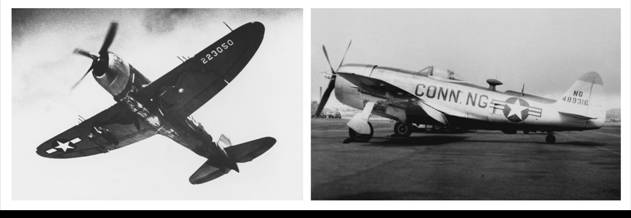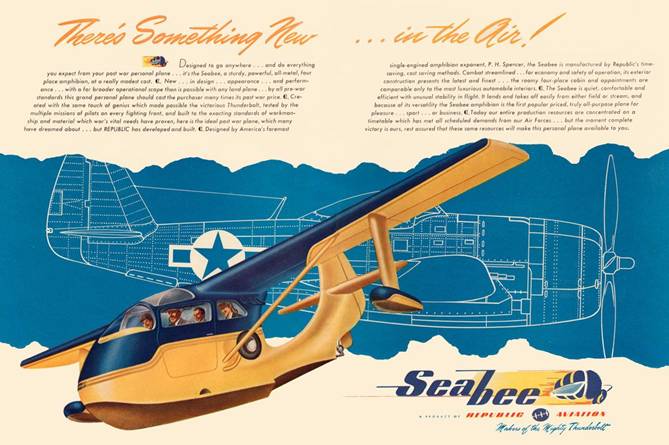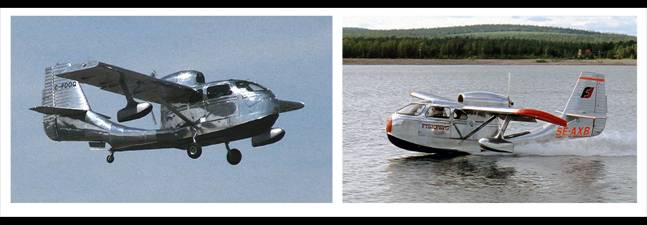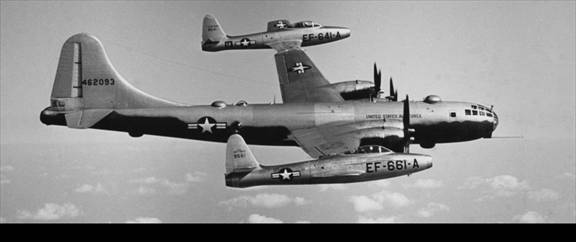Noisy
Neighbors Upstairs part two
of three As
a child who first lived beneath the flight path to/from LaGuardia, I got
used early to airliners' flying overhead.
When my family moved to This
is the second of three articles about what those noisy flying
"somethings" were. In
July's Hixnews, Ancient Hixtory
covered Mitchel Air Force Base's contribution to 1950s air traffic
over Republic Aviation Republic's
story begins with a one-legged "ace" WW I pilot, Alexander de
Seversky (shown above, with his prosthetic leg covered by a suit), who
had flown for the Imperial Russian Navy in the war's early years.
His engineering qualifications and combat success led to In
1931, he founded Seversky Aircraft, hiring at least two other
expatriates from the Russian Empire.
One of them, Alexander Kartveli, would be head engineer.
In the 1930s, Seversky Aircraft built the P-43 Lancer
fighter (shown below left, as illustrated in a 1940s publication).
It was purchased both by the U.S. Army and by the forces of
friendly foreign nations. At
the time, the Lancer was
faster and higher-climbing than its contemporaries, but as the decade
ended, its performance was surpassed by that of new German and Japanese
aircraft.
Despite
the company's track record, and the promising new aircraft it already
was developing for the military, Seversky Aircraft was deeply in debt.
In 1939, de Seversky was ousted from the business he had founded,
which then became Republic
Aviation. Kartveli
became Republic's Chief Engineer, continuing for decades to design
impressive aircraft (models of which are shown with him, above) that
earned him renown throughout the industry. ***
Levering
what it had learned from the P-43, Republic developed the P-47 Thunderbolt,
first flown in 1941. As a
fighter, bomber escort, and ground-attack aircraft, it became a stalwart
of wartime American airpower. Nearly
16,000 Thunderbolts were built. Army
Air Force P-47s flew in and out of Mitchel and Republic throughout the
1940s. When they were
retired from the Air Force, they continued to fly overhead for the Air
National Guard until 1955. *** As
World War II wound down, many government aircraft orders were cut back
or canceled. With the
future demands of
The
newspaper photo on the right, taken only two weeks after the end of WW
II, shows employees at the LIRR's Republic stop.
These are the first of 5,000 workers called back from furlough,
so that they can begin work related to new civilian aircraft.
The other photo shows a P-47 (foreground) and the two aircraft on
which those employees were to work: the four-engined XF-12 Rainbow,
and the little RC-3 Seabee
amphibian. The
XF-12 ('X' designating 'experimental') had been developed at the
request of the Army during the war, as the prototype for a high-speed,
high-altitude reconnaissance aircraft.
The Army never followed through on the project, leaving Republic
with the Rainbow - the fastest four-engined non-jet aircraft ever built.
In 1945, the company hoped to redevelop it into a fast airliner,
funding its redesign and construction with advances from the airlines
which would buy it. The
airline industry, however, did not want to fund the creation of a
40-passenger airliner that would fly at 450+ mph.
It preferred to save its money until jet airliners became
feasible. Until then, it
would spend only a little at a time, to have other manufacturers extend
their existing airliner designs into Super
Constellations and DC-6s,
so that airlines could pack in more passengers per plane.
It took time, but Republic finally realized it would never get
the money it needed for the project, and it finally abandoned the
Rainbow.
Note:
The idea of airlines' waiting for jet airliners as early as the late
1940s was not far-fetched. The
De Havilland DH 106 Comet (above), the world's first
jet airliner, began flying commercially in 1952. In
contrast to the XF-12, the RC-3 amphibian was put into production, and
hundreds were sold. The
push-prop SeaBee had been
designed in expectation of a strong post-war economy, in which personal
aircraft would be sold retail, much as automobiles were.
Alas,
the boom economy proved less robust than Republic had hoped, and most
Americans were not ready to buy their own airplanes.
Only about 1,000 Sea Bees
were built in all. Now and
then, I would see one flying over
*** The
Republic plane I noticed most frequently overhead (it was noisy, per its name) was the F-84 Thunderjet - used more by the USAF than any other attack aircraft
during the Korean War. It
was fast; early in its testing it topped 607 mph, setting a new American
air speed record.
Republic
incrementally changed - and made experimental versions of - many of
its aircraft, including the Thunderjet.
One version could even be launched from a truck trailer if no
runway was available - not that it could ever land
back on that trailer.... *** In
1954, the Thunderjet morphed
into the swept-wing F-84F
Thunderstreak, which went on to serve in the regular USAF until
(depending on a given unit's role) 1958-1962, and in the Air National
Guard into the 1970s. Note
the Republic sign on the hangar in the background below.
*** Early
jet fighters burned too much fuel to travel great distances - which
meant that they could not protect American bombers on non-stop flights
to, say, targets deep in the In
preliminary tests, a single-engine propeller plane tried to dock to a
C-47 transport. In the early
test flights, it failed to dock - as the tips of the two aircrafts'
wings approached each other, their respective air flows met, creating
too much turbulence. In
later flights the aircraft did dock successfully: the connecting
hardware had been lengthened, keeping the actual wing tips slightly
apart, which diminished the wing-tip turbulence. A
more ambitious series of USAF test flights began in 1950, conducted
jointly with Republic, and based in Farmingdale.
It used two of the new F-84 fighters and a B-29 bomber -
aircraft faster, larger, heavier, and more demanding of piloting skills
than those used in the preliminary tests.
In addition, the docking itself would be more difficult - the
coupling devices on the wing-tips were such that the aircrafts' wings
had to meet (as seen below).
When
the tests began, wing-tip turbulence proved even more treacherous than
expected, and the pilots constantly struggled to maintain control.
The Thunderjets could
dock to the Superfortress only
briefly. By October 1950,
however, the well-practiced pilots were able to fly linked for as long
as two hours and thirty minutes. The
flights were then paused for more than two years, so that Republic could
develop an automated unit to take control of the docked fighters,
relieving their pilots of the need to manually compensate for
ever-changing turbulence. Testing
resumed in March 1953, but it was soon terminated.
On April 24th, with one fighter docked to the bomber,
a sudden onset of turbulence ripped large pieces from the B-29's wing,
and from the fuselage of the Thunderjet.
Crippled and in flames, both broken airplanes plunged to earth.
The jet crashed into a wood and burned; the B-29 sank into Note
the deliberate vagueness of the following AP news report:
***
The
F-105 Thunderchief was
Republic's last (and fastest) fighter/bomber of the 1950s.
It could achieve Mach 2 - twice the speed of sound.
I suspect that F-105s were responsible for some of the occasional
sonic booms I heard in In
*** By
1960, Alexander de Seversky's ideas about strategic air power -
which indirectly had given birth to Republic Aviation - seemed passť,
as the country looked beyond aircraft to rockets.
Very soon, Hereafter,
smaller portions of the defense budget would be allocated to developing
new aircraft. After all,
hanging missiles from the wings of almost any airplane would transform
it into an effective attack weapon.
Large bombers soon would be obsolete; smaller airplanes - fast,
agile, and versatile - might replace them, and serve other purposes,
too. Someday, the same
adaptable aircraft design might serve multiple branches of the service,
rather than the respective branches' each relying on aircraft designed
only for them. With
missiles shouldering the burden of In
hindsight, it is no surprise that in 1965 Republic was purchased by
Fairchild (builder of the utilitarian Flying
Boxcars mentioned in the July article about Mitchel Field). After
completing the remainder of Republic's contract work, Fairchild began
to slowly spiral
to its own demise. It kept
going for a while by sub-contracting, building subassemblies for other
manufacturers (e.g., portions of wings for Boeing 747s).
Attempting to re-establish itself as a complete aircraft
manufacturer, it unsuccessfully partnered with failing European makers
of civilian aircraft. Ultimately,
Fairchild's business ceased, and it was scavenged.
Its assets were purchased by a coalition of two financial
companies, likely because they could serve as the basis for a tax loss.
They were resold to a third company, which sold them yet again,
this time to an electronics corporation.
Like Republic itself, Fairchild was no more. *** Although
Republic Aviation no longer exists, its site in Farmingdale survives.
It has become the home of the
*** Post Script
Sheet
music! Clearly, the man
loved the very idea of flight. End
of Part Two |













